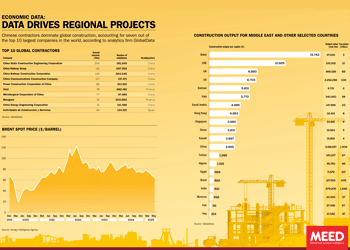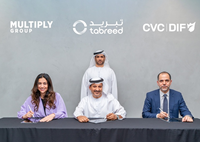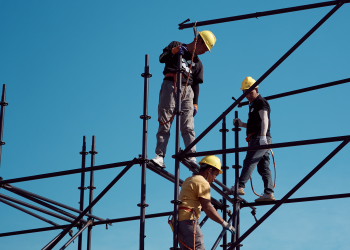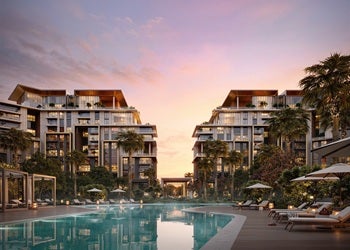Jeddah plans $31bn airport expansion
29 May 2023

Register for MEED’s guest programme
Jeddah Airports Company (Jedco) plans to transform King Abdulaziz International airport (KAIA) into one of the world’s largest airports with a SR115bn ($31bn) expansion plan that will increase its capacity to 114 million passengers a year.
The largest components of the plan cover the design and expansion of Terminal 1 and the construction of a new passenger terminal to be called Terminal 2.
The expected completion date for the expansion project is 2031.
Terminal plans
The Terminal 1 project comprises basic infrastructure and enabling works, the installation of new gates, air bridges and parking aprons, the extension of the automatic people mover, new baggage conveyor systems and lounges, with the goal of increasing annual passenger capacity by 15 million.
Work on the multibillion-dollar scheme is scheduled to start this year, with completion targeted for 2026.
The Terminal 2 project aims to increase the airport’s total capacity to 114 million passengers a year, almost tripling the airport’s 40 million limit today.
Due to start in 2026 and end by 2031, the project will involve constructing a completely new terminal building with dozens of gates, new taxiways, aprons, roads, utilities, and baggage handling and other software systems. It is likely to be worth in excess of $10bn to build.
Jedco is also planning to construct a fourth runway starting in 2025 and completing by 2029 to cope with the increased traffic. Due to space limitations, the new runway will require substantive infrastructure relocation work to accommodate it.
Passenger traffic-focused developments are not the only element of the plan. As part of growing the airport’s commercial proposition, the client is also due to start developing a new logistics area later this year.
Covering more than 3 square kilometres, the facility will house new customs and service buildings as well as several leasable warehouses for the private sector. Construction of the facilities will be implemented in phases with an ultimate scheduled completion date of 2029.
Concurrently, Jedco is building a new Hajj and Umrah terminal. Pilgrims comprise a large portion of passenger traffic, and the new arrivals and departures hall for budget airlines will be able to handle 15 million passengers a year. The project is expected to be completed by 2025.
Another project starting this year is the construction of a new baggage handling facility to expand the airport’s existing capacity. The building will be located next to Terminal 1 and will be integrated with the existing conveyor belt systems.
Passenger demand
The project investment programme is a result of Jedco’s forecast that annual demand will reach 114 million passengers by 2030. Of this figure, the authority estimates 51 million will come from Saudi Arabian Airlines, 21 million from international airlines, and 13 million and 12 million from budget airlines Flynas and Flyadeal, respectively.
The forecast and plans were created in conjunction with key drivers of future passenger demand in the Mecca and Jeddah region, including gigaproject real estate developers Roshn and Uptown Jeddah, air cargo handler Saudi Logistics Services (SAL), and the General Civil Aviation Authority (Gaca) with its subsidiary Matarat Holding. Engineering firms Atkins, Mace and DGJ also inputted into the process. The three companies are the consultants on the capital projects investment plan.
KAIA has three operational terminals. Opened in 2018, Terminal 1 is one of the world’s largest passenger terminals, and caters primarily for the state carrier and domestic flights. The North Terminal handles international airlines, while the Hajj Terminal is dedicated to pilgrim traffic.
Construction work on KAIA has been a key driver of airport-building activity in Saudi Arabia in the past. In 2010, there were over $7bn of contract awards for work at the airport, marking the most active year for airport construction activity on record, according to regional projects tracker MEED Projects.
There are other major airport projects planned in Saudi Arabia. In November, Saudi Arabia’s Crown Prince Mohammed bin Salman bin Abdulaziz al-Saud announced the masterplan for King Salman International airport in Riyadh. If completed on time in 2030, it will become the largest airport in the world in terms of passenger capacity.
The airport aims to accommodate up to 120 million passengers by 2030 and 185 million by 2050. For cargo, the goal is to process 3.5 million tonnes a year by 2050.
Neom airport
Another major airport is planned for Neom. US firm Aecom confirmed on 22 March that it had been awarded a contract to provide project management consultancy (PMC) services for the new airport project.
The airport will be inland, close to the Tabuk end of the 170-kilometre-long Line development. Neom International airport is separate from the Neom Bay airport, which started receiving commercial flights in 2019.
Although not confirmed, it is understood that the first phase of the airport will have the capacity to handle 25 million passengers a year. A second phase could take the capacity up to 50 million passengers a year. There is an aspiration for the airport to become the largest in the world, with a capacity of 100 million passengers a year.
Regional airports
Smaller domestic airports are also being developed. In March, Matarat signed a three-year contract with France’s Egis Group to provide technical support and project management services for 26 regional airports.
The contract aims to establish phased project management portals, update airport project management policies and procedures, and provide technical support for planning and designing.
The contract also involves following up on the implementation of capital projects with Matarat subsidiaries, including Riyadh Airports Company, Jeddah Airports, Dammam Airports and Cluster2.
Exclusive from Meed
-
 June 2025: Data drives regional projects
June 2025: Data drives regional projects30 June 2025
-
 UAE-Turkiye financial links strengthen
UAE-Turkiye financial links strengthen30 June 2025
-

-
 Iraq approves Basra housing project
Iraq approves Basra housing project30 June 2025
-
 Meraas announces Dubai City Walk expansion
Meraas announces Dubai City Walk expansion30 June 2025
All of this is only 1% of what MEED.com has to offer
Subscribe now and unlock all the 153,671 articles on MEED.com
- All the latest news, data, and market intelligence across MENA at your fingerprints
- First-hand updates and inside information on projects, clients and competitors that matter to you
- 20 years' archive of information, data, and news for you to access at your convenience
- Strategize to succeed and minimise risks with timely analysis of current and future market trends

Related Articles
-
 June 2025: Data drives regional projects
June 2025: Data drives regional projects30 June 2025
Click here to download the PDF
Includes: Top 10 Global Contractors | Brent Spot Price | Construction output
To see previous issues of MEED Business Review, please click herehttps://image.digitalinsightresearch.in/uploads/NewsArticle/14171168/main.gif -
 UAE-Turkiye financial links strengthen
UAE-Turkiye financial links strengthen30 June 2025
 This package on UAE-Turkiye relations also includes:
This package on UAE-Turkiye relations also includes:> UAE-Turkiye trade gains momentum
> Turkiye’s Kalyon goes global

Turkish bank DenizBank is one of Turkiye’s leading private banks and, as a wholly owned subsidiary of Emirates NBD since 2019, it is playing a leading role in developing business links between the UAE and Turkiye.
Recep Bastug, who was appointed as DenizBank’s CEO in 2024, says there is great potential for trade between the two countries.
“Turkiye is a growing country,” he says. “We’ve had volatility over the past five years, but the Turkiye economy and the banking sector have been able to manage those periods successfully.”
Having spent years with international institutions such as BBVA, Bastug has vast experience in the banking sector. “Turkish banks, especially private ones like DenizBank, are very successful. In terms of capital, balance sheet structure and digital transformation, we are in a strong position,” he says.
 Solid fundamentals
Solid fundamentalsTurkiye’s fundamentals remain solid with a diversified export-oriented economy, a young and skilled population of 85 million, and relatively low debt levels. “We are not a highly leveraged country. Our household debt-to-GDP ratio is low. With the right policy mix, we offer high potential for foreign investors,” says Bastug.
That potential is increasingly being realised through growing engagement with the GCC and the UAE. “Turkiye’s connection with the Gulf is going up, and DenizBank is set to play a serious role in these relations. Day by day, Turkish companies are expanding their footprint in the region.”
GCC projects
Baştug says that many of these companies approach DenizBank to help facilitate their entry into Gulf markets. “Some of our clients are extremely well capitalised, but others need support for major projects. Just recently, one Turkish company announced a $3bn project in the region. We’re helping them connect with Emirates NBD and navigate the local financial landscape.”
DenizBank is actively supporting the creation of trilateral partnerships – particularly between Turkiye, the UAE and Saudi Arabia. “We see huge opportunity in forming financial strongholds across these markets, leveraging Turkiye’s contractor experience, the UAE’s capital and Saudi Arabia’s scale,” says Baştug.
DenizBank is already delivering results. “With Emirates NBD, we’ve identified 10 strategic cooperation areas, including trade finance, payments and capital markets. Thanks to this partnership, Emirates NBD has become the number one debt capital markets bank in Turkiye, even ahead of global players.”
One area of growing activity is initial public offering (IPO) participation. “We’ve launched a mutual fund that allows Turkish private banking clients to participate in IPOs from the region, including from the UAE and Saudi Arabia. It’s a diversification strategy and helps retain wealth within the group.”
Turkiye’s connection with the Gulf is going up, and DenizBank is set to play a serious role in these relations. Day by day, Turkish companies are expanding their footprint in the region
Recep Bastug, DenizBankInflation ends
Despite the current inflationary environment, Bastug says there is a clear inflection point ahead. “We expect 2027 to be a turning point. Once we exit the inflationary accounting regime [in Turkiye], DenizBank will become one of the biggest contributors to Emirates NBD’s global balance sheet. Last year, we contributed $1.2bn. In 2027, it will be significantly more.”
DenizBank is the fifth-largest private bank in Turkiye with about a 5% market share. “The largest private bank is at 13%. It’s not easy to close that gap – but we will do it. Our long-term goal, aligned with our shareholder, is to become the biggest and most successful private bank in the country.”
The bank is especially focused on agriculture, SMEs, and export financing – sectors that are deeply relevant to
Turkiye’s economic growth and to regional demand. “We are the leading agricultural bank in Turkiye, and we believe strongly in the sector’s future – both for local consumption and exports.”Regional opportunities
Bastug also sees potential for engagement beyond the GCC, including in post-conflict reconstruction. “In the past, Turkiye had strong trade volumes with Syria. Even during wartime, commercial links remained. Once a stable environment emerges, there will be opportunities – especially in infrastructure.”
While a physical branch presence is not currently being considered, DenizBank is prepared to support Turkish contractors operating in neighbouring countries. “We have the relationships and expertise to facilitate this growth. And culturally, we’re well aligned with the region – it helps make business smoother.”
As Turkiye re-establishes economic momentum and Gulf economies look to deliver on long-term visions, DenizBank is positioning itself for a more active role in the region in the future. “We are preparing the bank for the next stage, and with the backing of Emirates NBD, we’re confident in our ability to lead.”
READ MORE
> UAE-Turkiye trade gains momentum
> Turkiye’s Kalyon goes globalhttps://image.digitalinsightresearch.in/uploads/NewsArticle/14170372/main.gif -
 Multiply agrees to sell Pal Cooling to Tabreed and CVC
Multiply agrees to sell Pal Cooling to Tabreed and CVC30 June 2025
Abu Dhabi-based investment company Multiply Group has agreed to sell all of its shares in its district cooling subsidiary Pal Cooling Holding (PCH) for AED3.8bn ($1bn) to a consortium comprising Engie-backed National Central Cooling Company (Tabreed) and CVC DIF.
The transaction is still subject to regulatory approvals.
MEED exclusively reported in May that a team comprising Tabreed and CVC was holding exclusive discussions to acquire PCH.
Multiply Group initially acquired a 100% stake in PCH and its subsidiaries in July 2021.
Multiply Group has been advised by Standard Chartered and Clifford Chance. Tabreed and CVC DIF have been advised by Citi, Synergy Consulting and White & Case.
The transaction brings together two of the UAE’s leading district cooling players. PCH was founded in 2006 and operates five active district cooling plants across the UAE. The company maintains eight long-term concessions and strategic partnerships with some of the UAE’s leading real estate developers, servicing key residential, commercial and mixed-use developments – most notably on Abu Dhabi’s Reem Island.
Tabreed owns and operates 92 plants, including 76 in the UAE, five in Saudi Arabia, eight in Oman, one in Bahrain, one in India and one in Egypt, in addition to other international projects and operations.
https://image.digitalinsightresearch.in/uploads/NewsArticle/14170511/main.jpg -
 Iraq approves Basra housing project
Iraq approves Basra housing project30 June 2025
Iraq has approved plans to build a housing project in Basra that will offer about 5,000 homes in the first phase to tackle the country’s rising housing shortage.
The project, which is endorsed by Iraq’s National Investment Commission (NIC), will cover an area of about 3 square kilometres.
According to local media reports, Basra province governor Asaad Al-Idani said the project has already been awarded to a developer.
Iraq has been gradually recovering since the war. The government initially prioritised infrastructure and public housing to stimulate economic growth, improve living standards and attract foreign investment.
More recently, benefitting from higher oil prices and a period of relatively stable governance, Baghdad has expanded its focus to reconstructing and modernising the country’s deteriorating infrastructure.
The Iraqi construction market has also seen significant investments from private real estate developers from the region. In May, Egyptian real estate developer Ora Developers announced that it had started construction on the Al-Wardi residential city project, which consists of more than 100,000 residential units covering about 61 million square metres (sq m) on the southeastern side of Baghdad.
The move is the latest sign of international investors’ growing appetite for developing real estate in Iraq as part of the country’s post-war building initiatives.
Also in May, another Egyptian firm, Talaat Moustafa Group Holding, said it was in negotiations with the NIC to develop a mixed-use project. The project, which will cover an area of about 14 million sq m and will be located in the southwest of Baghdad, is expected to contain about 45,000 residential units.
The positive sentiment has been particularly buoyed by a robust 2024 budget, which allocated nearly $42bn to transport, social infrastructure and housing initiatives.
Looking ahead, Iraq’s construction industry is expected to register an annual average growth rate of 4.9% in 2025-28, supported by further investments in energy, infrastructure and housing projects, according to UK analytics firm GlobalData.
MEED’s June 2025 report on Iraq includes:
> COMMENT: Iraq maintains its pace, for now
> GOVERNMENT & ECONOMY: Iraq’s economy faces brewing storm
> OIL & GAS: Iraqi energy project value hits decade-high level
> PIPELINES: Revival of Syrian oil export route could benefit Iraq
> POWER: Iraq power sector turns a page
> CONSTRUCTION: Iraq pours billions into housing and infrastructure projects
> DATABANK: Iraq forecast dips on lower oil priceshttps://image.digitalinsightresearch.in/uploads/NewsArticle/14170011/main.png -
 Meraas announces Dubai City Walk expansion
Meraas announces Dubai City Walk expansion30 June 2025
Register for MEED’s 14-day trial access
Local real estate developer Meraas has announced the City Walk Crestlane project as it continues to expand its City Walk residential community in the Al-Wasl area of Dubai.
The City Walk Crestlane comprises two residential towers offering 198 one-, two-, three-, four- and five-bedroom units.
The project is expected to be completed and handed over by the third quarter of 2028.
Earlier this month, Meraas, which is part of Dubai Holding Real Estate, awarded a construction contract for another project at City Walk.
The local firm Naresco Contracting was awarded a AED450m ($123m) contract for the main construction works on its Central Park Plaza residential project at City Walk.
The project involves constructing two towers with 23 and 20 floors. Together, they will have 212 residential units.
In May, Meraas awarded another local firm, Al-Sahel Contracting Company, a AED300m contract for the main construction works on Elara, which is phase seven of the Madinat Jumeirah Living masterplan in Dubai.
The project involves building three residential towers with 234 apartments.
https://image.digitalinsightresearch.in/uploads/NewsArticle/14169472/main.jpg

